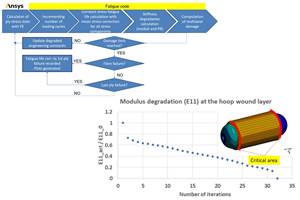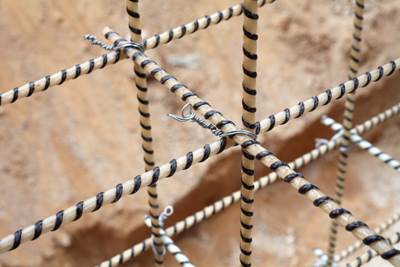Composite test methods (and specifications) for fiber-reinforced concrete structures
While initially focused on transitioning existing standards published by the American Concrete Institute, the relatively new ASTM Subcommittee D30.10 is developing new standardized test methods and material specifications for FRP composites.

Figure 1. ASTM D7617 transverse shear test fixture and specimen. Photo Credit, all images: Dan Adams
Back in October 2020, my CW column provided an “insider’s perspective” into ASTM standards for composites, describing how the test standardization process takes place. I focused on ASTM Committee D30, which develops and maintains the standardized test methods for composite materials. The D30 committee consists of seven technical Subcommittees, focusing on editorial and resource standards, constituent/precursor properties, lamina and laminate test methods, structural test methods, interlaminar properties, sandwich constructions and composites for civil structures.
To most of us who regularly attend ASTM D30 meetings, the last Subcommittee listed, D30.10 on Composites for Civil Structures, is one that we’re less familiar with. The reason? Most ASTM D30 meetings are co-located with other composites-related meetings and conferences, such as Composite Materials Handbook (CMH-17) meetings as well as the American Society for Composites, SAMPE and CAMX conferences.
However, Subcommittee D30.10 meetings are typically held in conjunction with meetings of the American Concrete Institute (ACI) Committee 440 on Fiber Reinforced Polymer Reinforcement. The reason for having separate meetings has a lot to do with the applications of the standards produced by this ASTM D30 Subcommittee as well as the Subcommittee’s history. In this column, I’ll focus on the test standards produced by ASTM Subcommittee D30.10.
Subcommittee D30.10 was officially added to ASTM Committee D30 on Composites in 2011. Before it became a separate ASTM D30 Subcommittee, composite test methods for civil structures had been balloted through the existing D30.05 Structural Test Methods subcommittee since 2006. However, technical meetings leading up to balloting of these new ASTM standards took place at ACI Subcommittee 440K meetings on fiber-reinforced polymer (FRP) material characteristics. In fact, the initial six composites test methods for civil structures published by ASTM were transitioned from “guide test methods” that had been published previously by the ACI.
These initial test methods that transitioned to ASTM were associated with composite materials used as internal reinforcement for concrete (ASTM D72051, ASTM D73372 and ASTM D76173), as well as externally bonded composite materials used to strengthen and repair concrete structures (ASTM D76164, D75225 and D75656). A majority of the guide test method development for these six test methods had been performed previously through ACI Subcommittee 440K. However, the ASTM standardization process typically required further test fixture development and validation as well as additional testing.
Since ASTM Subcommittee D30.10 was established, ACI Committee 440 has maintained jurisdiction over design codes and construction specifications, while ASTM has assumed jurisdiction over test standards. Currently, Subcommittee D30.10 has a total of 14 published ASTM standards, 12 of which are test methods or practices and two that are ASTM specifications. A listing of the current Subcommittee D30.10 standards is provided in Table 1. Additionally, there are several working items under development. In general, the test methods developed to date have continued to focus on two common uses of FRP for infrastructure applications: Externally bonded composites for strengthening and repairing concrete, and composites used as internal reinforcements within concrete structures. However, new work items are expanding into other pultruded FRP applications for civil engineering.
Of the current Subcommittee D30.10 test methods, ASTM D75656 is likely to be the most familiar to those involved in composites testing. This tensile test method is similar to the widely used ASTM D30397 test method for laminated composites and is used with unidirectional (UD) and 0°/90° cross-ply composite laminates. However, this D30.10 tensile test method is intended for measuring the tensile strength, modulus and ultimate tensile strain of FRP materials used for strengthening metals, timber and reinforced concrete.
Another of the initial test methods transitioned to ASTM Committee D30 is a tension-loaded single-lap shear test, ASTM D76164. This test method is used to determine the length of an overlap splice required to produce tension failure in a wet layup composite material away from the splice region. Among the differences between this Subcommittee D30.10 test method and other ASTM D30 test methods is the provision of specific guidance on specimen fabrication for the overlap splices which are typically applied and cured in the field. Additionally, ASTM D7616 prescribes specific procedures used in the construction industry for computing test results.
Four of the current Subcommittee D30.10 standards listed in Table 1 focus on FRP composite bars used for internally reinforcing concrete. ASTM D72051 focuses on tensile testing of FRP bars used as tensile elements in concrete. Because these bars have textured coatings or undulating surfaces, and due to the transverse shear properties of UD FRP materials, sleeves are attached to, or bonded over, the gripped regions at the ends of the bar and used to anchor the specimen when tensile loading. The ultimate tensile strength, ultimate tensile strain and modulus of elasticity of the composite bars are determined.
Similarly, ASTM D76173 describes a method for transverse shear testing of FRP composite bars. A section of bar is placed into the test fixture as shown in Fig. 1 that supports the bar along the outer lengths. A centrally located blade loads the central 25-millimeter length of the bar, producing double-shear loading. The test is used to measure the transverse shear strength of FRP bars for applications such as joints in concrete pavement.
As mentioned previously, two of the currently published ASTM D30.10 standards are standard specifications: ASTM D79578 and ASTM D85059. Since standard specifications are unique to Subcommittee D30.10, they remain unfamiliar to many ASTM D30 members not associated with this Subcommittee. Unlike conventional ASTM test methods, for a given application ASTM specifications identify the type of materials, geometric requirements and the tests required to characterize and qualify the technological solution for a given application. The two current D30.10 standard specifications are associated with solid, round cross-section FRP bars used for reinforcing concrete. Whereas the ASTM D7957 specification covers straight and bent-shaped glass fiber-reinforced vinyl ester bars, the ASTM D8505 specification covers straight sections of epoxy and vinyl ester bars reinforced with either glass or basalt fibers. Additionally, ASTM D8505 specifies higher minimum strength and modulus FRP bars compared to ASTM D7957. Both standard specifications provide physical, mechanical and geometric property requirements as well as the test methods to be used for qualification, quality control and certification.
Additional information on ASTM Subcommittee D30.10 is available on the Committee D30 webpage at https://www.astm.org/committee-d30. Information on the ACI Committee 440 on Fiber Reinforced Polymer Reinforcement is available here.
References
1 ASTM D7205/D7205M-21, “Standard Test Method for Tensile Properties of Fiber Reinforced Polymer Matrix Composite Bars,” ASTM International (W. Conshohocken, PA, U.S.), 2021 (first issued in 2006).
2 ASTM D7337/D7337M-12 (2019), “Standard Test Method for Tensile Creep Rupture of Fiber Reinforced Polymer Matrix Composite Bars,” ASTM International (W. Conshohocken, PA, U.S.), 2019 (first issued in 2007).
3 ASTM D7617/D7617M-11 (2017), “Standard Test Method for Transverse Shear Strength of Fiber-Reinforced Polymer Matrix Composite Bars,” ASTM International (W. Conshohocken, PA, US), 2017 (first issued in 2011).
4 ASTM D7616/D7616M-11 (2017) “Standard Test Method for Determining Apparent Overlap Splice Shear Strength Properties of Wet Lay-Up Fiber-Reinforced Polymer Matrix Composites Used for Strengthening Civil Structures,” ASTM International (W. Conshohocken, PA, U.S.), 2017 (first issued in 2011).
5 ASTM D7522/D7522M-21, “Standard Test Method for Pull-Off Strength for FRP Laminate Systems Bonded to Concrete or Masonry Substrates,” ASTM International (W. Conshohocken, PA, U.S.), 2021 (first issued in 2009).
6 ASTM D7565/D7565M-10 (2017), “Standard Test Method for Determining Tensile Properties of Fiber Reinforced Polymer Matrix Composites Used for Strengthening of Civil Structures,” ASTM International (W. Conshohocken, PA, U.S.), 2017 (first issued in 2009).
7 ASTM D3039/D3039M-17, “Standard Test Method for Tensile Properties of Polymer Matrix Composite Materials,” ASTM International (W. Conshohocken, PA, U.S.), 2017 (first issued in 1971).
8 ASTM D7957/D7957M-22, “Standard Specification for Solid Round Glass Fiber Reinforced Polymer Bars for Concrete Reinforcement,” ASTM International (W. Conshohocken, PA, U.S.), 2022 (first issued in 2017).
9 ASTM D8505/D8505M-23, “Standard Specification for Basalt and Glass Fiber Reinforced Polymer (FRP) Bars for Concrete Reinforcement,” ASTM International (W. Conshohocken, PA, U.S.), 2023 (first issued in 2023).
Related Content
Numerical tool with mean stress correction demonstrated for fatigue life estimation of thermoplastic composites
To aid design of fatigue-resistant structures, Econ Engineering has developed an algorithm to evaluate ply-based cyclic stiffness degradation combined with an FE failure check, validated for a CF/PAEK pressure vessel.
Read MoreMulti-scale 3D CT imaging enables digital twinning, high-fidelity simulation of composite structures
Computed tomography (CT) provides highly accurate 3D analysis of internal microstructure, performance simulation of carbon fiber/PEEK satellite strut.
Read MorePhotothermal tomography for locating, quantifying defects in composites
Years of infrared testing development result in thermography technology that is no longer just qualitative, but can define defect size and depth, making additional UT scans obsolete.
Read MoreMeasuring ply-wise deformation during consolidation using embedded sensors
Strip-type shape sensor method claims real-time measurement of ply-wise deformation.
Read MoreRead Next
Notched testing of sandwich composites: The sandwich open-hole flexure test
A second new test method has been standardized by ASTM for determining notch sensitivity of sandwich composites.
Read MoreNew standard specification supports non-metallic FRP rebar
ASTM International standard D8505 enables further integration of FRP rebar into infrastructure applications.
Read MorePlant tour: Daher Shap’in TechCenter and composites production plant, Saint-Aignan-de-Grandlieu, France
Co-located R&D and production advance OOA thermosets, thermoplastics, welding, recycling and digital technologies for faster processing and certification of lighter, more sustainable composites.
Read More






















